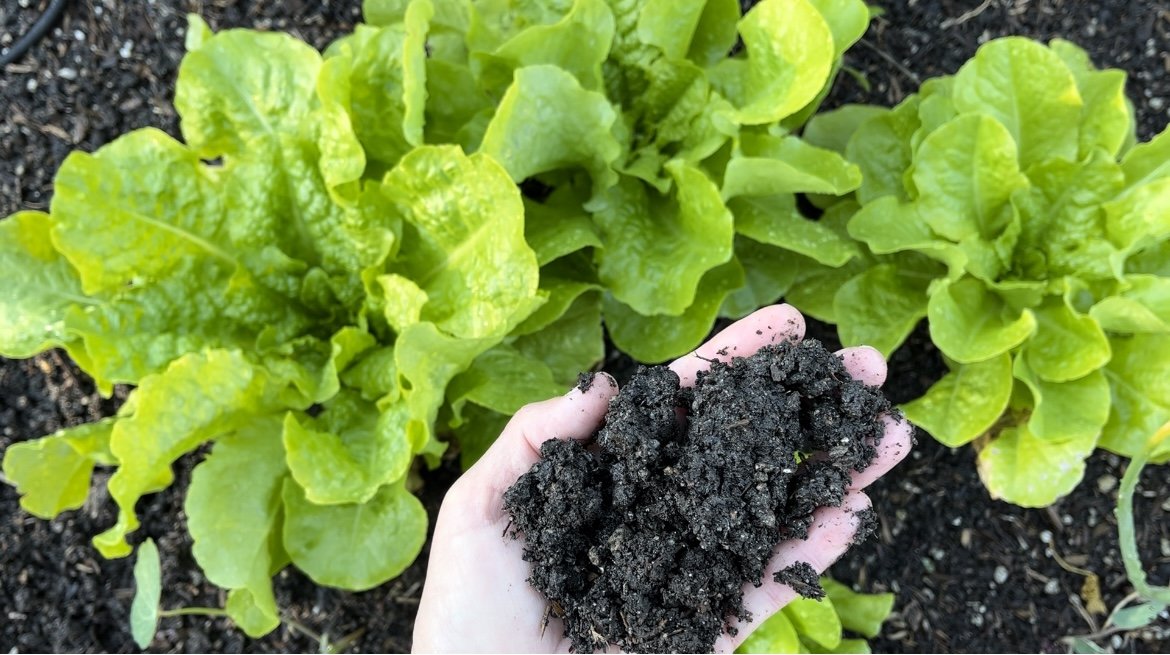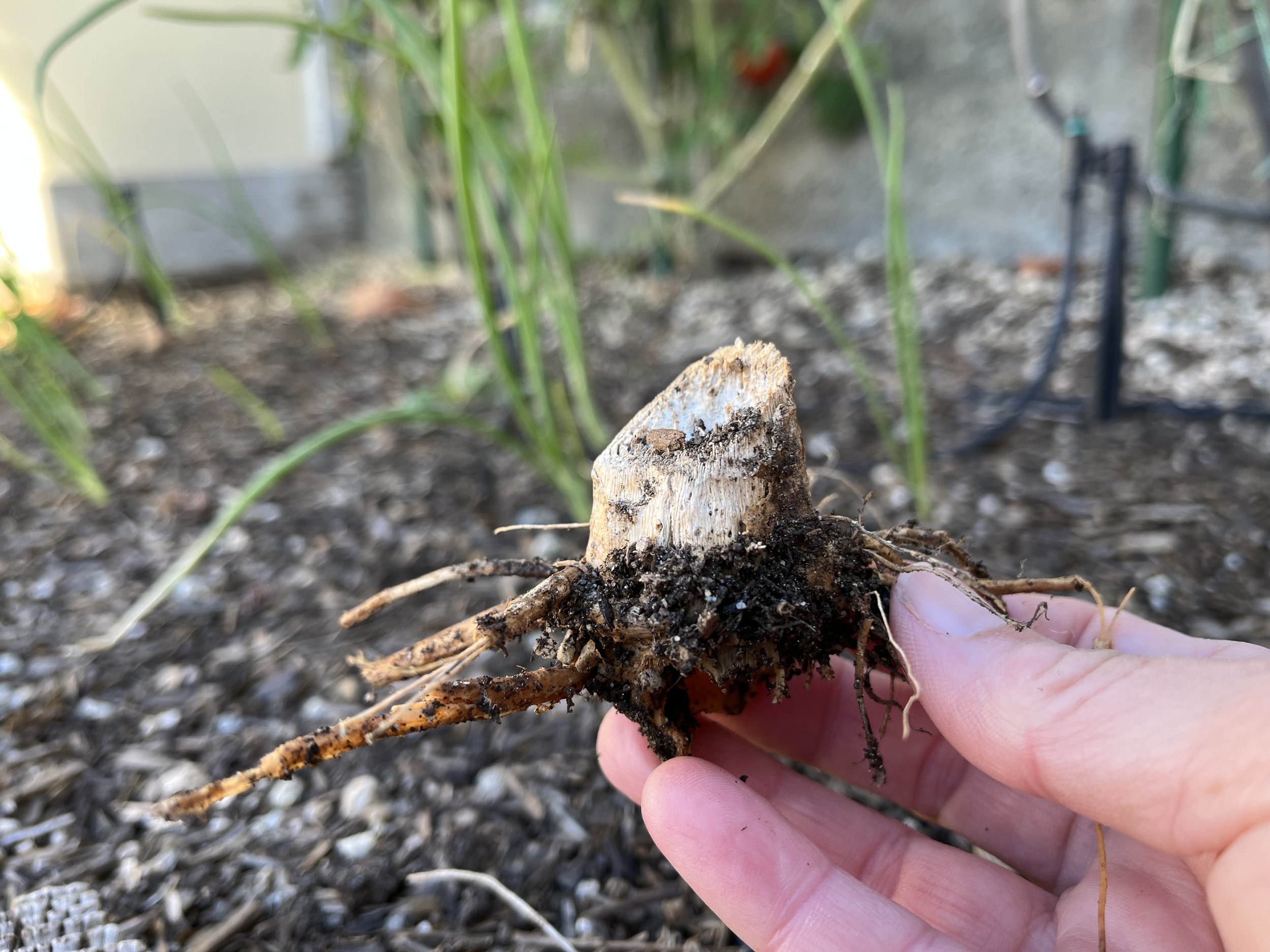It All Starts In The Soil
SCG raised bed soil 2023
healthy soil = healthy plants = nice fruit or vegetable harvests
When we started growing our edible landscape there was no usable healthy soil. our ground is completely DG (decomposed granite). although there were some minerals, there was definitely not much nutrients and no microbial life. over the years we have built up healthy soil by bring in, Edna’s best by EB Stone. Edna’s has lots of great ingredients like: aged fir bark, aged redwood, peat moss, pumice, earthworm castings, feather meal, bat guano and others. We also added lots of compost to all of our growing areas.
We also grow “no dig” as much as possible. sometimes that’s not possible when we’re growing in small containers, but one thing that we always focus on whether in ground or in containers is soil health.
An article by Penn State extension titled: “understanding and managing soil microbes”, notes - “beneficial soil microbes perform fundamental functions, such as nutrient cycling, breaking down crop residues and stimulating plant growth.” science has shown how important microbes are for soil health. keeping the beneficial microbial life in tack is one of our goals. an excellent source to learn about “no dig” and the function of a healthy microbial network throughout the soil is Charles Dowding, market gardener in the UK. He has many books and a great youtube channel full of information. We have learned a great amount from his teachings.
SCG summer harvest table 2022
There is still a lot to learn about beneficial microbes and their role in soil health and plant health but his successful results with the food he grows speaks volumes to the importance of leaving the microbial network in tack if possible.
And it is possible to do this even growing in containers. what we do is once the plant is finished producing, we cut the plant down at the soil level. once this happens most plants, except for lettuces & some brassicas, those can keep putting out baby sprouts out of the main root stem.
SCG - decomposed plant root
But most other plants will die off. then after a couple months the roots dry up and are easily removed from the soil leaving most of the microbial network in tack. On the left is an image of a root from a plant we cut down at the soil level, it lifted up very easily a couple months later because all of the smaller root webbing disintegrated into the soil, basically they became compost.
Another important aspect to soil health is nutrients. check out our article on “feeding & fertilizing”. adding organic compost to the soil is adding food for the microbial life.
The same article mentioned earlier by Penn State extension titled: “understanding and managing soil, microbes” goes on to say “soil microbes need access to nutrition and water”.
Charles Dowding’s model is layering his homemade compost on top of each of his growing areas when he is ready to plant a new crop. the compost replenishes the nutrients in the soil feeding the microbial network.
Here is a great article from, soilbiotics.com explaining what we know about beneficial microorganisms in the soil.
Biological fertility:
Biological fertility refers to the many varied organisms and microorganisms that live in the soil. They are responsible for many vital processes in the soil, including advancement of the nutrient and carbon cycles.
Each group of soil microbes has different characteristics that define the organisms and different functions in the soil it lives in. And most importantly, these organisms do not exist as independent players, they interact with all other groups and these interactions influence soil fertility as much or more than the organisms individual activities. Most numerous of the soil microbes are bacteria.
Bacteria are single celled, microscopic organisms, and are the most abundant microbes in the soil. There are bacteria species that are weak, and may be killed off by slight changes in the soil environment. bacteria can be subdivided into the following four functional types.
Decomposers;
Most bacteria are decomposers that eat dead plant material and organic waste, releasing nutrients that other organisms consume, an essential component in early stages of the nitrogen cycle. Some decomposers can break down pesticides and pollutants in soil. Decomposers are especially important in immobilizing, or retaining nutrients in their cells, preventing the loss of nutrients, such as nitrogen from the root zone.
SCG - my beautiful mama harvesting 2021
Minimalists;
Nitrogen fixers; these extract nitrogen gas from the air and convert it into forms that plants can use. Visible nodules are created where bacteria infect a growing root hair. The plant supplies simple carbon compounds to the bacteria, and the bacteria convert nitrogen from air into a form the plant host can use. When leaves or roots from the host plant decompose, soil nitrogen increases in the surrounding area.
Nitrifying; these change ammonium to nitrite, then to nitrate a preferred form of nitrogen for grasses and most row crops. Nitrate is leached more easily from the soil, so some farmers use nitrification inhibitors to reduce the activity of one type of nitrifying bacteria. Nitrifying bacteria are suppressed in forest soil’s so that most of the nitrogen remains as ammonium.
Denitrifying; these convert nitrate to nitrogen or nitrous oxide gas. denitrifiers are anaerobic, meaning they are active where oxygen is absent, such as in saturated soil’s or inside soil aggregates.
Fungi function as:
Decomposers - saprophytic fungi - convert dead organic material into fungal biomass, carbon dioxide, and small molecules, such as organic acids.
Mutualists - the mycorrhizal fungi - colonize plant roots. in exchange for carbon from the plant, mycorrhizal fungi help to make phosphorus soluble and bring soil nutrients (phosphorus, nitrogen, and micronutrients) to the plant.
Algae functions in soil include:
Becoming additional organic matter and increasing organic carbon in soil when they die.
Binding soil particulates and thereby reducing and preventing soil erosion. helping to increase the water retention capacity of soil.
Here is the full article https://www.soilbiotics.com/files/Microbes_and_Soil_Health.pdf
These are all very important roles that microorganisms are offering, they benefit the plants showing the importance of keeping that network in tact and not disrupting it by excessive tilling and overturning the soil which breaks down the organism network in the soil.
More to come as we learn more about this complex creation.
enjoy your garden
tami🌱
resources
https://www.soilbiotics.com/files/Microbes_and_Soil_Health.pdf





